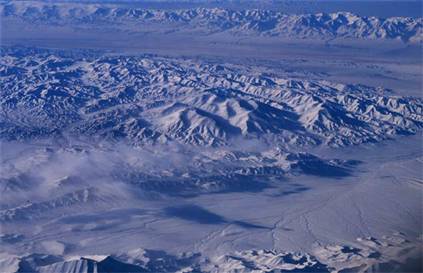| Ongoing studies of Martian analog habitats on Earth include some of the iciest regions and the driest areas. A new study, published in the Feb. 2007ref Journal of Geophysical Research-Biogeosciences, is the first comprehensive look at the microbial life in the extreme deserts of China.Results of this study of China’s remote deserts could help astrobiologists refine their maps for uncovering Martian life. |
| ref, Nanoclimate environment of cyanobacterial communities in China's hot and cold hyperarid deserts, J. Geophys. Res., 112, 1029 (2007). |
| Kimberley Warren-Rhodes, et al in their paper examined the abundance and diversity of blue-green algae called cyanobacteria in several spots in the extreme deserts of China. They analyzed linkages between cyanobacterial community abundance and climate across a wide range of environmental conditions and geographical distances in China's northwest region, an area containing some of the world's oldest, driest and most isolated deserts. |
 |
This aerial view shows a hyper-arid
desert near the Tianshan Mountain
Range in northwest China, where the Warren-Rhodes surveyed for
microbial life. photo by NASA |
|
The Dry Valleys in Antarctica (arguably the coldest place on Earth) and certain areas in the Atacama Desert of Chile (some of the driest places on Earth) previously provided a combination of of conditions which are similar to those on Mars indicated lead author Kimberley Warren-Rhodes and Chris McKay of NASA Ames Research Center. In the China deserts they chose three locations based on temperatures and amount of rainfall. One site, called Tokesun, was warm and dry and located about 500 feet (152 meters) below sea level, making it the lowest point in China. Another site, called Ruoqiang, runs parallel to the southern edge of the Taklimakan Desert and is hot and wet. The last site, Sorkuli, is situated along the Qinghai-Tibetan plateau and lies between 8,200 feet and 9,840 feet (2,500 meters to 3,000 meters) above sea level. This high-altitude desert included two climates: cold and dry, and cold and wet. Like green plants, cyanobacteria capture the sun’s energy to carry out photosynthesis and turn inorganic CO2 into organic sugars needed for growth. On Earth, water is the limiting factor for carrying out photosynthesis, and this would be particularly true on the parched planet of Mars. But ecologists suspect that microbes can live within rock pores or beneath translucent rocks where moisture is most likely to remain, possibly on both planets. Current monitoring and long-term climate data show that extreme heterogeneity in liquid water availability characterizes the cyanobacteria environment with rainfall and snowmelt being the main moisture sources. Warren-Rhodes measured micro-climate conditions, including the relative humidity, moisture, temperature and light levels in the soil, beneath rocks and within pore spaces of rocks. Mean annual precipitation (MAP) primarily dictated cyanobacteria ecology across sites with an increase in rainfall being typically associated with a spike in cyanobacterial density, but the effects of temperature, humidity and light created a gradient of soil water conditions suitable for life as well. There appears to be certain climatic characteristics that make it more probable to find microbial life in these really China harsh deserts. One feature is rock size, with the larger rocks supporting higher densities of cyanobacteria, presumably because they can store more water. A major conclusion of the research was that the high-altitude deserts in the Qinghai-Tibetan Plateau of China offers the coldest and driest recorded extremes for cyanobacteria on Earth and might be a model for Martian habitat studies. |
Kimberley A. Warren-Rhodes -
NASA-Ames Research Center,
Moffett Field, California,
USA.
Kevin L. Rhodes
- Department of Agriculture, Forestry and
Natural Resource Management,
University of
Hawaii, Hilo,
Hawaii,
USA.
Shuangjiang Liu
and Peijin Zhou
- Institute of Microbiology,
Chinese Academy of Sciences,
Beijing,
China.
Christopher P. McKay -
NASA-Ames Research Center,
Moffett Field,
California,
USA